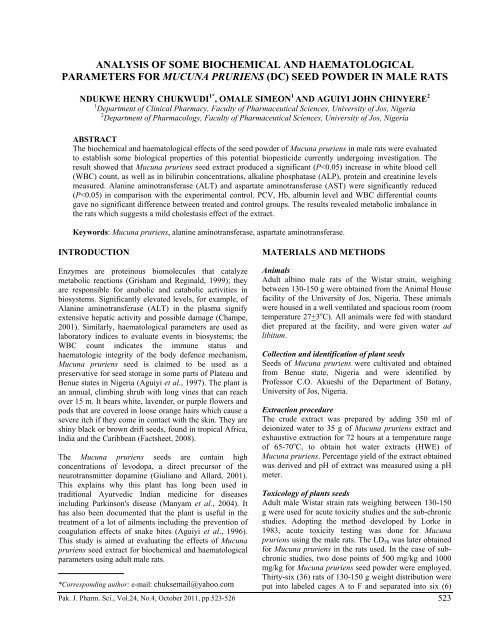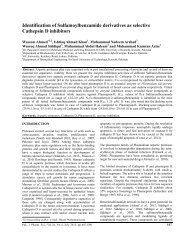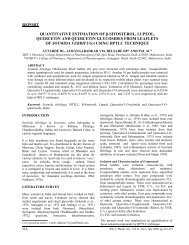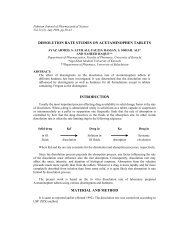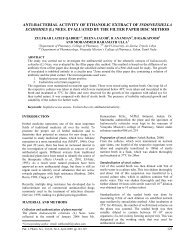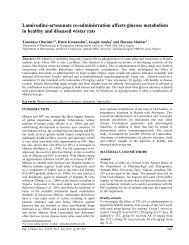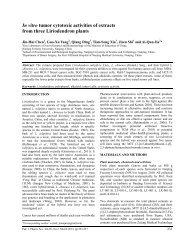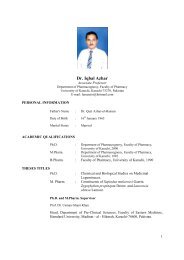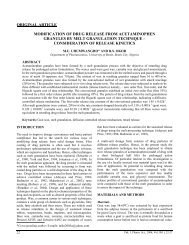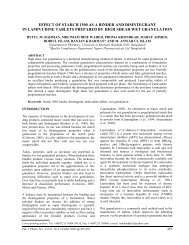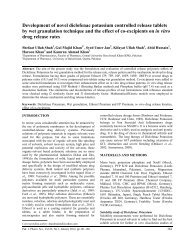Analysis of some biochemical and haematological parameters
Analysis of some biochemical and haematological parameters
Analysis of some biochemical and haematological parameters
You also want an ePaper? Increase the reach of your titles
YUMPU automatically turns print PDFs into web optimized ePapers that Google loves.
ANALYSIS OF SOME BIOCHEMICAL AND HAEMATOLOGICAL<br />
PARAMETERS FOR MUCUNA PRURIENS (DC) SEED POWDER IN MALE RATS<br />
NDUKWE HENRY CHUKWUDI 1* , OMALE SIMEON 1 AND AGUIYI JOHN CHINYERE 2<br />
1 Department <strong>of</strong> Clinical Pharmacy, Faculty <strong>of</strong> Pharmaceutical Sciences, University <strong>of</strong> Jos, Nigeria<br />
2 Department <strong>of</strong> Pharmacology, Faculty <strong>of</strong> Pharmaceutical Sciences, University <strong>of</strong> Jos, Nigeria<br />
ABSTRACT<br />
The <strong>biochemical</strong> <strong>and</strong> <strong>haematological</strong> effects <strong>of</strong> the seed powder <strong>of</strong> Mucuna pruriens in male rats were evaluated<br />
to establish <strong>some</strong> biological properties <strong>of</strong> this potential biopesticide currently undergoing investigation. The<br />
result showed that Mucuna pruriens seed extract produced a significant (P
<strong>Analysis</strong> <strong>of</strong> <strong>some</strong> <strong>biochemical</strong> <strong>and</strong> <strong>haematological</strong> <strong>parameters</strong><br />
Table 1: Effect <strong>of</strong> Extract <strong>of</strong> Mucuna pruriens on <strong>some</strong> <strong>biochemical</strong> <strong>parameters</strong> in male rats<br />
rats per group, <strong>and</strong> rats in first three cages were each<br />
administered 500 mg/kg <strong>of</strong> Mucuna pruriens. The rats in<br />
the remaining three cages were each administered 1000<br />
mg/kg <strong>of</strong> Mucuna pruriens. Administration <strong>of</strong> the extract<br />
was daily <strong>and</strong> lasted for six weeks. Biochemical <strong>and</strong><br />
<strong>haematological</strong> <strong>parameters</strong> were then evaluated at the end<br />
<strong>of</strong> the six weeks, using the method <strong>of</strong> Tienz (1970).<br />
STATISTICAL ANALYSIS<br />
All treatments were performed in triplicate using SPSS<br />
Version 16.0 2007, <strong>and</strong> each data point in the results is<br />
the mean <strong>of</strong> two or three replicate tests. All experiments<br />
were repeated at least once. The statistical significance <strong>of</strong><br />
a treatment effect was evaluated by student’s t-test <strong>and</strong><br />
the values were expressed as mean ± SEM (st<strong>and</strong>ard error<br />
<strong>of</strong> mean).<br />
RESULTS<br />
Treatment<br />
Percentage yield <strong>of</strong> Mucuna pruriens extract was 21.57%<br />
<strong>and</strong> pH <strong>of</strong> extract measured gave 8.76. The LD50 was<br />
obtained for Mucuna pruriens in male rats as 1300 mg/kg<br />
body weight.<br />
DISCUSSION<br />
Protein<br />
(g/l)<br />
Albumin<br />
(g/l)<br />
Control (untreated seeds) 70.46±0.14 44.50±0.17 40.00±0.58 131.33±0.88 445.23±0.07<br />
Mucuna (500 mg/kg) 80.43±0.20* 40.43±0.12 # 19.00±0.58 # 78.66±0.88 # 520.60±0.06*<br />
Mucuna (1000 mg/kg) 98.66±0.33* 54.80±0.05* 18.33±0.62 # 95.00±1.15 # 581.46±0.18*<br />
The measured pH <strong>of</strong> 8.76 for Mucuna pruriens revealed<br />
its tilt toward alkalinity which generally would not affect<br />
the action <strong>of</strong> the extract in vivo. There was significant<br />
difference (p
Table 3: Effect <strong>of</strong> Extract <strong>of</strong> Mucuna pruriens on <strong>some</strong> <strong>haematological</strong> <strong>parameters</strong> in male rats<br />
results were inconsistent with the findings from this work<br />
<strong>and</strong> could not be corroborated with other studies done.<br />
These findings <strong>of</strong> Ezeja <strong>and</strong> Omeh could have been linked<br />
to the method <strong>of</strong> extract preparation or methodology<br />
adopted by the scientific team. The results <strong>of</strong> this present<br />
research show that the biomarker enzymes were<br />
decreased <strong>and</strong> were detected rapidly, hence, can be used<br />
for the prediction <strong>and</strong> diagnosis <strong>of</strong> metabolic insults. The<br />
membrane bound target enzymes, Aspartate Amino<br />
transaminase (AST) <strong>and</strong> Alanine Amino transaminase<br />
(ALT) significantly decreased in liver tissues when<br />
measured after six weeks <strong>of</strong> treatment in relation to the<br />
control. The reason for this decreased observation in<br />
enzyme level has been attributed to the fact that M.<br />
pruriens is a known antioxidant (Aguiyi et al., 1996;<br />
Tripathi <strong>and</strong> Upadhyay, 2001). The results from this<br />
current study were consistent with a study that was<br />
obtained from treatment with methanolic extract <strong>of</strong><br />
Mucuna pruriens that showed a decrease in the levels <strong>of</strong><br />
lipid peroxidation <strong>and</strong> an increase the levels <strong>of</strong><br />
glutathione, superoxide dismutase <strong>and</strong> catalase. These<br />
results suggest that the extract <strong>of</strong> Mucuna pruriens seeds<br />
exhibits significant antitumor <strong>and</strong> antioxidant effects in<br />
mice (Rajeshwar et al., 2005). Therefore, the suppression<br />
<strong>of</strong> liver enzymes to significant amounts could be<br />
explained by the enhanced suppressive effect displayed<br />
by <strong>some</strong> components in Mucuna pruriens extract, thereby,<br />
preventing over-sensitization <strong>of</strong> enzymes to the<br />
metabolism <strong>of</strong> various substances foreign to the normal<br />
system in the rats used for the study.<br />
CONCLUSION<br />
Treatment PCV<br />
(%)<br />
Haematological <strong>and</strong> <strong>biochemical</strong> investigations carried<br />
out showed no significant difference (p>0.05) in the<br />
Ndukwe Henry Chukwudi et al.<br />
<strong>parameters</strong> measured for packed cell volume (PCV),<br />
haemoglobin (Hb), Albumin level <strong>and</strong> WBC differential<br />
counts. However, Mucuna pruriens caused an increase in<br />
total WBC count that was significant (p
<strong>Analysis</strong> <strong>of</strong> <strong>some</strong> <strong>biochemical</strong> <strong>and</strong> <strong>haematological</strong> <strong>parameters</strong><br />
Guliaeva NV, Luzina NL, Levshina IP <strong>and</strong> Kryzhanovski<br />
GN (1988). The inhibition stage <strong>of</strong> lipid peroxidation<br />
during stress. Bull. Eksp. Biol. Med., 106 (12): 660-<br />
663.<br />
Katzenschlager R, Evans A, Manson A, (all names <strong>of</strong><br />
authors instead <strong>of</strong> et al.) et al. (2004). Mucuna pruriens<br />
in Parkinson's disease: A double blind clinical <strong>and</strong><br />
pharmacological study. J. Neuro. Neurosurg. Psych.,<br />
75: 1672-1677.<br />
Lorke D (1983). A new approach to practical acute<br />
toxicity testing. Arch. Toxicol., 54: 275-287.<br />
Manyam BV, Dhanasekaran M <strong>and</strong> Hare TA (2004).<br />
Neuroprotective effects <strong>of</strong> the antiparkinson drug<br />
Mucuna pruriens. Phytotherapy Res., 18: 706-712.<br />
Rahman MF <strong>and</strong> Siddiqui MKJ (2003). Pesticides, food<br />
contaminants, <strong>and</strong> agricultural wastes (Part B). J. env. sci.<br />
<strong>and</strong> health, 38(1): 59-71.<br />
Rajaram N <strong>and</strong> Janardhanan K (1991). The <strong>biochemical</strong><br />
composition <strong>and</strong> nutritional potential <strong>of</strong> the tribal<br />
pulse, Mucuna gigantea (Willd.) DC. Plt. Foods<br />
Human Nutri., 44: 45-51.<br />
526<br />
Rajeshwar Y, Gupta M <strong>and</strong> Mazumder UK (2005).<br />
Antitumor activity <strong>and</strong> in vivo antioxidant status <strong>of</strong><br />
mucuna pruriens (Fabaceae) seeds against Ehrlich<br />
ascites carcinoma in Swiss albino mice. Ir. J. Pharm.<br />
<strong>and</strong> Therap., 4: 46-53.<br />
Tietz NW (1970). Colorimetric method <strong>of</strong> serum aspartate<br />
<strong>and</strong> alanine aminotransferase. In: Fundamentals <strong>of</strong><br />
Clinical Chemistry, WB Saunders (ed.), Philadelphia,<br />
London, p.447.<br />
Tripathi YB <strong>and</strong> Upadhyay AK (2001). Antioxidant<br />
property <strong>of</strong> Mucuna pruriens. J. Cur. Sci., 80(11):<br />
1377-1378.<br />
Vaidya RA, Allorkar SD, Seth AR <strong>and</strong> P<strong>and</strong>ay SK<br />
(1978). Activity <strong>of</strong> bromoergocryptine, Mucuna<br />
pruriens <strong>and</strong> L-Dopa in the control <strong>of</strong><br />
hyperprolactenaemia. Neurol., 26: 179-186.<br />
Pak. J. Pharm. Sci., Vol.24, No.4, October 2011, pp.523-526


